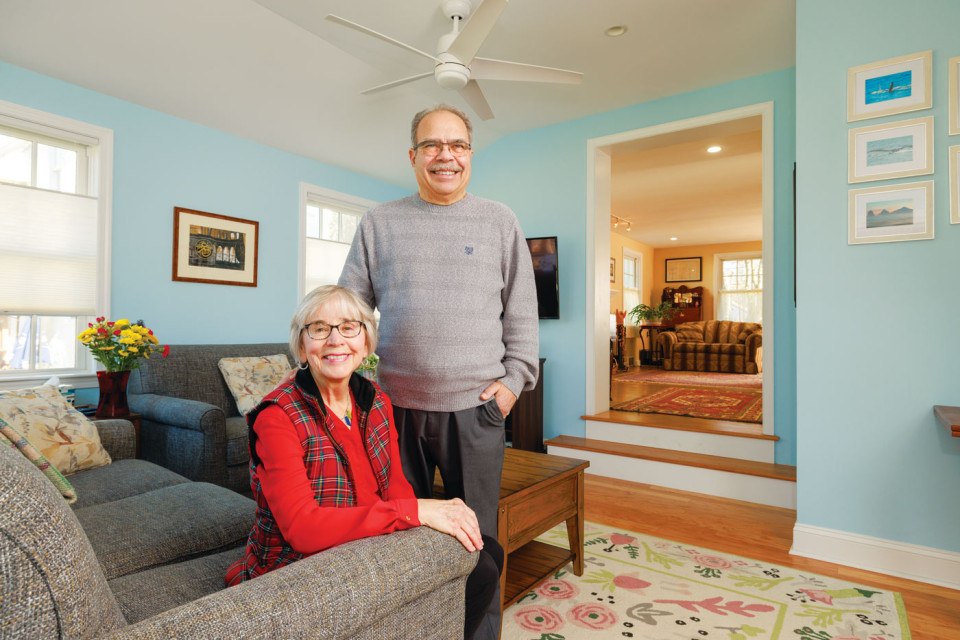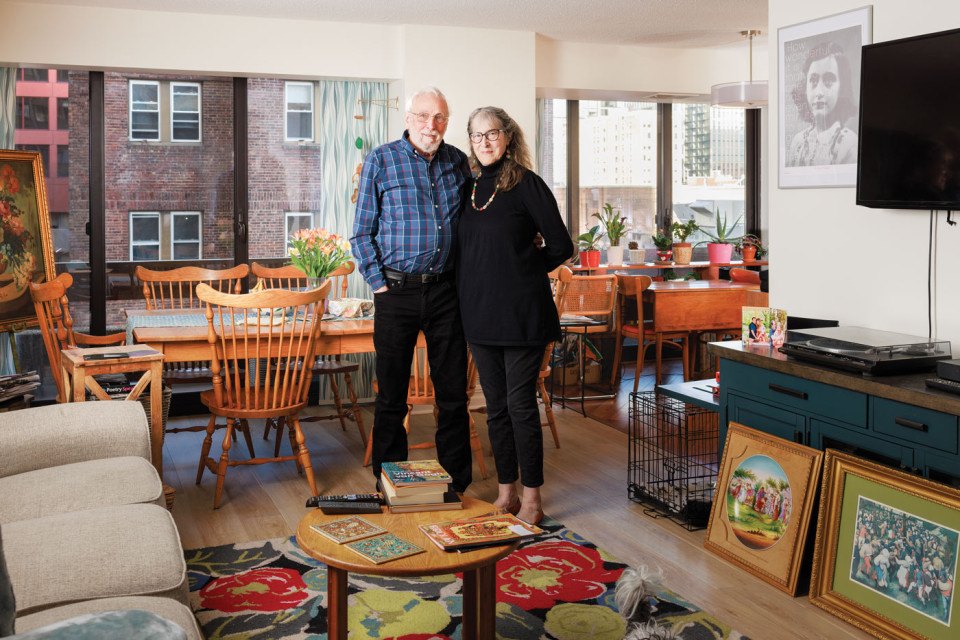Looking to Downsize? Here’s How These Philly Homeowners Did It
True stories from baby boomers who shed their larger homes for a smaller footprint

Eileen DiFranco holds a photograph of her old home in East Mount Airy. She’s one of many Philly-area Baby Boomers who are downsizing their homes. / Photography by Colin Lenton
Considering downsizing your home? Here are true stories from Philly-area boomers who shed their larger houses for a smaller footprint —how it started and how it’s going.
From a “Big, Rambling” House in the Northwest to a Cozy Montco Abode

Larry and Eileen DiFranco
Larry is an associate broker at Elfant Wissahickon Realtors. Eileen is the pastor at St. Mary Magdalene Community.
Moved From: A 3,465-square-foot seven-bedroom Tudor house in East Mount Airy
To: A 1,392-square-foot (plus 280-square-foot addition) three-bedroom colonial house in Flourtown, purchased for $382,350 at the end of 2020
How It Started: The DiFrancos’ move to a smaller house was seven years in the making. It also happened by chance.
“We updated our kitchen in 2013 with the idea that we would be moving in the next five to seven years,” says Larry. “But we wanted not just to update the kitchen and move, but to update the kitchen and enjoy it for a few years before we moved.”
And while they did, they slowly got the rest of their “big, old, rambling Mount Airy house” — Eileen’s description — ready for its inevitable sale. The to-do list was long. Its 108-year-old terra-cotta roof, untouched since the house was built, needed to be replaced to address a design flaw that caused leaking during heavy storms. The DiFrancos knew knob-and-tube wiring would be a deal-killer, so they updated the electrical system. They installed new windows in the dining room and painted the exterior.
And they occasionally checked out possible locales for a move. “We were looking, but we weren’t actively looking,” says Larry. The two differed a bit on their goals; while they both wanted a smaller house, Larry also wanted one that would cost a lot less.
The Move: Then they found a house right across the street from the home of one of their sons. “It just made sense to live nearby,” Larry says. “I work with him. They have two children, and it was nice to be near our grandchildren.” “We all get along,” adds Eileen.
How It’s Going: In this case, the only reason they bought this house was location, location, location. “The house didn’t necessarily attract us,” says Larry. “I hated it,” says Eileen. So no sooner had they closed the sale and moved in than they started remodeling it. Eileen wanted a family room, a deck and a porch, so they added all three. They turned the powder room on the first floor into a full bath and put a sofa bed in the family room, so that if the time came when they couldn’t climb the steps easily, they could sleep on the main floor.
The DiFrancos made their move across the city line with some reluctance; both had lived in Philadelphia their entire lives and had called Mount Airy home since 1976. “I am not a suburban-housewife type,” says Eileen, “so I never wanted to move to the suburbs. But as we got older, it made sense to move closer to our sons.”
From a Longtime Home in the City to a Condo Over the Border

Sheena Austin
Retired city employee
Moved From: A 1,852-square-foot three-bedroom rowhouse in West Oak Lane
To: A 1,674-square-foot two-bedroom condo in Elkins Park, for $234,000 in the summer of 2022
How It Started: Sheena Austin began thinking about moving when she witnessed her husband struggling with tasks like climbing stairs as he became more seriously ill. But she didn’t start the moving process until a few months after he passed away, when her kids expressed concern about her living alone in her rowhome.
She also knew there were chores she didn’t want to face: “I worried more about taking care of the outside — the lawn, raking leaves, shoveling snow. And I didn’t want to see myself dealing with that for X number of years.”
The Move: Her goal, then, was to shrink the outside of her residence, not the inside. She did so by purchasing a condo in the Briar House, a building near the Elkins Park train station that has many older residents. (She says she’s on the young side there.) The building is close to several shopping districts and the former home of her mother, whom Austin cared for as she struggled with dementia before entering a long-term care facility.

How It’s Going: While the building does have some common amenities that Austin makes use of — including an outdoor pool and a community room with programmed events — she misses the anonymity of living in her own house. She says it’s nice, for instance, to have the building staff help her load her groceries in a portable shopping cart in the underground parking garage, but she’d like to just waltz into her apartment with no one noticing. “And anybody coming to see me has to go through the front desk and show ID, which is good for security,” she says. “But then you don’t have as much privacy.”
“I am glad I did this when I was in good health and able to make my own decisions,” she adds of the move. “It’s very taxing, especially at this point in your life, when you’ve accumulated more things. To make the move, I had to make a lot of tough decisions” about what to keep and what to give away or sell, especially items that reminded her of her husband and his passions.
But, she says, she’d advise anyone contemplating a move in their later years: “Better sooner than later.”
From a Big Mount Airy Home to a Retirement Community

Marilou and Peter Buffum
Marilou is a retired teacher, social worker and real estate agent. Peter is a prison reform advocate and teacher who took up real estate sales with his wife.
Moved From: A 3,500-square-foot five-bedroom-and-den Craftsman/colonial house in East Mount Airy
To: An 1,500-square-foot two-bedroom unit in the Cathedral Village continuing-care retirement community in Andorra, in the spring of 2023. They paid a total of $492,000 in entrance and estate fees and renovations.
How It Started: Though Marilou and Peter Buffum are slightly older than the baby-boomers cohort — both were born in the early 1940s — neither felt the need to move into a continuing-care retirement community (CCRC). But since they could foresee a future when they would, they made the decision while they were still fully in charge of their faculties. Besides, their East Mount Airy home was becoming increasingly hard to live in, from the 12 stone steps leading to the front door to the lack of a first-floor powder room.
The Move: They didn’t decide with equal enthusiasm. “The choice to move was actually my husband’s, and I became a very reluctant trailing spouse,” says Marilou. “I didn’t think I was old enough to move to a continuing-care community, and I knew giving up the amount of space we had in the house was going to be an issue for me.”
Like many active older Americans, Marilou doesn’t see herself as stereotypically old. (It’s worth noting here that most CCRCs accept applicants as young as 55.) Yet she was able to make peace with the decision by seeing it as a form of preventive medicine. “If we needed extra care in the future, we wanted to get into a place where we could get to know people and be part of the community before that happened,” she says.
And they have. “Over here, we’ve got a whole bunch of new friends, as it were,” Peter says. “But we still have the ability to invite our old friends over.”
How It’s Going: Marilou says the community has lots of activities to occupy their time and that they have to actively balance their old and new lives. She describes herself as not much of a rule-follower and chafes somewhat at the community’s constant scheduling of everything. But she loves the convenience of, say, being served dinner in a dining room every night.
Marilou says they also considered just moving to a smaller house in the area. They even toyed with the idea of moving to the vacation house they own in Rhode Island, but that would have taken them too far away from children and grandchildren.
And she’s happy with the layout of their new home: “It’s much smaller, but the living space is easier because it’s one long, airy open space, with 12-to-15-foot ceilings in the living room, with skylights and a tremendous amount of light coming in.”
Merging Two Chestnut Hill Households Into One Center City Condo

Amy Small-McKinney and Robert Rossman
Small-McKinney is a poet, writer, former journalist, teacher and counselor. Rossman is a retired computer programmer.
Moved From: His large 2,032-square-foot five-bedroom Victorian twin house and Amy’s modest 1,000-square-foot two-bedroom apartment in Chestnut Hill
To: A 1,209-square-foot two-bedroom condo in Washington Square West, purchased in the fall of 2023 for $362,500

How It Started: Amy Small-McKinney and Robert Rossman prove that love can blossom at any stage in life. And that love may make you do things you hadn’t planned on doing.
The two had both lost their spouses when they met via an online dating site in 2021. Small-McKinney had already downsized; she and her husband, Russell, had moved from their Blue Bell home of 25 years to Hill House at Chestnut Hill in 2015 because of Russell’s chronic illness. Rossman, on the other hand, still lived in the big house he and his wife bought in the same neighborhood when they moved back to Philadelphia from Detroit in 1976.
Rossman’s son loved the neighborhood. “When I first moved to Chestnut Hill with him, he was in sixth grade,” Rossman recalls. “And he said, ‘Dad, this is the best place we ever lived. When you walk down the street, if you smile at people, they smile back. If you say hello, they say hello to you. It’s just a wonderful place.’”
Small-McKinney, on the other hand, would rather have moved into Center City from Blue Bell but had compromised on Chestnut Hill to be closer to her husband’s doctors.
The Move: Both wanted to be closer to the attractions and activities of Center City. And Rossman knew they needed to live on one floor rather than in a sprawling house like his. So they scouted condos around Washington Square before finally settling on the Center City One unit they moved into.
One reason they chose it: The building is pet-friendly. The couple share their space with Rossman’s dog, a Havanese named Dudley.

How It’s Going: The condo is actually a little bigger than Small-McKinney’s Chestnut Hill flat: 1,200 vs. 1,000 square feet. But both still had some deaccessioning to do when they moved. One item Rossman couldn’t hang onto was the Hobart commercial mixer he inherited from his father, who’d kept it after closing the delicatessen he ran. He actually used it, too — he would prepare 20 to 30 pounds of gefilte fish every year for Passover. But it was too big for their condo’s galley kitchen. Small-McKinney had to part with 90 percent of the 1,000-book library she and her husband had built. “I can see why so many people don’t want to do it,” she says of deaccessioning, “because it’s so hard on many levels.”
The couple are still getting settled into their new digs, and Rossman hasn’t sold his house yet — he hung onto it in case the new living arrangement proved unworkable. But he’s now ready to put it on the market for the spring selling season.
>> Click here to return to Real Estate Trends for 2024: The Great Downsizing
Published as “The Great Downsizing: Boomer Buyer Profiles” in the March 2024 issue of Philadelphia magazine.


